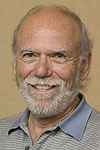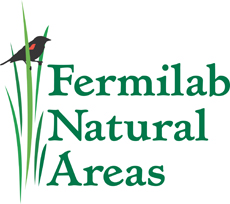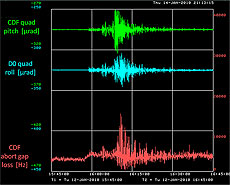|
Have a safe day!
Tuesday, Jan. 19
2:30 p.m.
Particle Astrophysics Seminar (NOTE DATE) - One West
Speaker: Marcelle Santos, University of Sao Paulo
Title: Galaxy Cluster Analysis of the SDSS Coadd Data
3:30 p.m.
DIRECTOR'S COFFEE BREAK - 2nd Flr X-Over
THERE WILL BE NO ACCELERATOR PHYSICS AND TECHNOLOGY
SEMINAR THIS WEEK
Wednesday, Jan. 20
10:30 a.m.
Research Techniques Seminar - Curia II
Speaker: John Thome, Ecole Polytechnique Federale de Lausanne
Title: Two-Phase Cooling of Targets and Electronics for Particle Physics Experiments
3:30 p.m.
DIRECTOR'S COFFEE BREAK - 2nd Flr X-Over
4:00 p.m.
Fermilab Colloquium -
1 West
Speaker: Evan Finch, Yale University
Title: A Hint of Local Parity Violation in QCD? Recent Results from the STAR Collaboration
Click here for NALCAL,
a weekly calendar with links to additional information.
Upcoming conferences |
|
|
For information about H1N1, visit Fermilab's flu information site.
|
|
Tuesday, Jan. 19
- Bagel sandwich
- Creamy turkey vegetable soup
- Chili dog
- Country-fried steak
- Chicken cacciatore
- Italian panini w/ provolone
- Assorted sliced pizza
- Super burrito
Wilson Hall Cafe Menu
|
|
Wednesday, Jan. 20
Lunch
- Penne pasta w/ spinach & mushrooms in Alfredo sauce
- Green salad
- Italian cream cake
Thursday, Jan. 21
Dinner
- Pasta carbonara
- Stuffed filet of sole w/ crabmeat
- Sautéed spinach w/ lemon & pine nuts
- Salad of field greens, pear & shaved parmesan
- Pecan rum cake
Chez Leon Menu
Call x3524 to make your reservation.
|
|
|
Evolving the ILC baseline
 |
| Barry Barish, director of the ILC Global Design Effort, wrote this column. |
Over the past year, the ILC project managers have led a focussed effort to assess the ILC baseline configuration that is documented in the Reference Design Report (RDR) and as a result have developed a set of proposed baseline changes that are aimed at reducing costs and improve the technical design. The SB2009 Proposal Document outlines a set of proposed changes, includes descriptions of each change, as well as some discussion of the pros and cons. The first step in evaluating this proposal was a review last week in Oxford, UK, by our Accelerator Advisory Panel (AAP), an internal committee that advises me on technical and management issues. I will discuss the AAP recommendations in a forthcoming column, once they deliver their report to me. Today, I address some of the general features of the proposal.
To a large extent the original motivation for this study was to find major cost savings relative to the RDR. As stated in the proposal document, "The adopted approach to re–baselining is based on an assumption that the RDR design – although sound – is both conservative in many of its design decisions, relatively immature from a detailed engineering standpoint, and is "performance–driven" as opposed to cost optimised."
But, a key result of this study is that, even if we adopt all of SB2009, it would result in cost savings of only 10–15 percent, and these changes could even introduce some associated performance degradation and some areas of increased technical risks. We can immediately draw as a very important conclusion of this intensive one–year study the observation that the RDR is already close to being a cost–to–performance optimised design. Therefore, we should be very selective and only adopt changes that on balance improve performance, reduce risks, make a better overall design or make cost savings without significantly degrading the other factors.
 |
Topological diagram of the proposed changes in the ILC central area, a much more coherent integration of this very complex central region containing the sources, damping rings, beam delivery systems, detectors, etc.
|
Read more
-- Barry Barish
|
New bimonthly publication from Fermi Natural Areas

Fermi Natural Areas, an environmental science program of FRA, recently published its inaugural newsletter. The group will publish the newsletter bimonthly. The mission of Fermi Natural Areas is to restore, manage and conserve Fermilab's natural areas in support of the laboratory's science mission, and to encourage Fermilab's neighbors to experience and enjoy Fermilab's natural beauty. The newsletter highlights upcoming and past events, environmental and wildlife updates from sightings and events on site and beautiful images of Fermilab's natural scenery.
View the newsletter here.
|
Supernova winds blow galaxies into shape
From ScienceNews, Jan. 13, 2010
After years of struggling to understand how to properly assemble a galaxy, astronomers have discovered that the answer is blowin' in the wind. The supernova wind, that is.
New computer simulations show that winds generated by supernovas, which are the explosions of massive stars, can push stars out from the center of a dwarf galaxy. This simulation of supernova winds redistributes both ordinary matter and invisible dark matter in a way that almost perfectly matches observations of the way matter is distributed in actual dwarf galaxies. Fabio Governato of the University of Washington in Seattle and his colleagues describe their simulations in the Jan. 14 Nature.
Previous attempts to model galaxy formation based on the highly successful theory of cold dark matter - which states that invisible material must account for 85 percent of the mass of the universe - have done "an awesome job" of explaining such global properties as where, when and how many galaxies should form, notes Governato. But the models have failed to reproduce some of the key features of individual galaxies.
Read more
|
|
|
Working in India
 |
| Fermilab Director Pier Oddone is in India this week. Look for his next Director's Corner on Tuesday, Jan. 26. Photo courtesy of Wikimedia.org |
|
Tevatron feels Haiti quake
 |
This screen image from the Tevatron main control room shows how the earthquake in Haiti affects superconducting quadrupole magnets in the accelerator tunnel during a one-hour period. The green line shows forward and backward pitch of a magnet near the CDF detector, while the blue line shows the side-to-side roll of a magnet near the DZero detector. The abort gap line shows much less than 1 percent of the beam jiggled out of alignment in one monitoring area. None of the movements would be visible with the naked eye.
|
Minutes after the 7.0-magnitude earthquake in Haiti on Tuesday shook whole blocks of Port-au-Prince into dust, physicists hundreds of miles away in Illinois knew something terrible had occurred.
The crew operating the particle beam for the Fermilab Tevatron, the world's highest-energy proton-antiproton collider, hadn't yet seen images of the toppled buildings; that would come later on the television news. But the squiggles on their computer screens spoke of devastation.
They had seen squiggles like these before-during a 2007 quake in Mexico, a 2006 quake in New Zealand, and earthquakes that triggered deadly tsunamis in Sumatra in 2005 and Indonesia in 2004.
The readings came from sensors on underground magnets that steer particles around the four-mile Tevatron ring. They record vibrations too tiny for people at the laboratory to feel, including seismic waves from distant earthquakes. Big spikes usually mean big trouble somewhere in the world.
A December symmetry magazine article explains how physicists first noticed the Tevatron's super sensitivity, and how they work to make sure it doesn't interrupt the laboratory's multi-million-dollar research efforts.
Read more
-- Tona Kunz
|
|